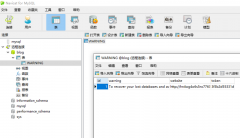python数据库操作指南之PyMysql使用详解
时间:2023-12-07Python数据库操作指南之PyMysql使用详解
什么是Python数据库操作指南之PyMysql使用?
PyMysql是Python操作MySQL数据库的一个模块,它可以方便的进行数据库的连接、查询、增加、修改、删除等操作,是非常常用的Python数据库操作模块之一。
本文将详细介绍Python数据库操作指南之PyMysql使用。
PyMysql的安装
在使用PyMysql之前,需要先安装PyMysql模块。可以使用pip命令进行安装:
pip install PyMySQL
PyMysql的连接
使用PyMysql连接数据库需要以下步骤:
- 导入PyMysql模块
- 创建数据库连接
- 创建游标对象
下面是使用PyMysql连接数据库的示例:
import pymysql
# 创建数据库连接
db = pymysql.connect(host="localhost", user="root", password="123456", db="test")
# 创建游标对象
cursor = db.cursor()
# 关闭数据库连接
db.close()
其中,host表示数据库的地址(本地的话为localhost),user表示数据库的用户名,password表示数据库的密码,db表示要连接的数据库名。
PyMysql的查询操作
使用PyMysql进行查询操作需要以下步骤:
- 创建查询语句
- 执行查询语句
- 获取结果
下面是使用PyMysql进行查询操作的示例:
import pymysql
# 创建数据库连接
db = pymysql.connect(host="localhost", user="root", password="123456", db="test")
# 创建游标对象
cursor = db.cursor()
# 查询语句
sql = "SELECT * FROM users"
try:
# 执行SQL语句
cursor.execute(sql)
# 获取所有记录列表
results = cursor.fetchall()
# 打印结果
for row in results:
id = row[0]
username = row[1]
password = row[2]
print(f"id: {id}, username: {username}, password: {password}")
except:
print("Error: unable to fetch data")
# 关闭数据库连接
db.close()
上面的代码中,fetchall()方法可以获取所有查询结果,返回的是一个元组,每一个元组是一条记录。
PyMysql的增加操作
使用PyMysql进行添加操作需要以下步骤:
- 创建数据库连接
- 创建游标对象
- 创建添加语句
- 执行添加语句
- 提交事务
下面是使用PyMysql进行添加操作的示例:
import pymysql
# 创建数据库连接
db = pymysql.connect(host="localhost", user="root", password="123456", db="test")
# 创建游标对象
cursor = db.cursor()
# 添加语句
sql = "INSERT INTO users(username, password) VALUES ('alice', '123456')"
try:
# 执行SQL语句
cursor.execute(sql)
# 提交事务
db.commit()
print("Add data successfully")
except:
# 回滚事务
db.rollback()
print("Error: unable to add data")
# 关闭数据库连接
db.close()
上面的代码中,commit()方法用于提交事务,rollback()方法用于回滚事务。
PyMysql的修改操作
使用PyMysql进行修改操作需要以下步骤:
- 创建数据库连接
- 创建游标对象
- 创建修改语句
- 执行修改语句
- 提交事务
下面是使用PyMysql进行修改操作的示例:
import pymysql
# 创建数据库连接
db = pymysql.connect(host="localhost", user="root", password="123456", db="test")
# 创建游标对象
cursor = db.cursor()
# 修改语句
sql = "UPDATE users SET password='1234567' WHERE username='alice'"
try:
# 执行SQL语句
cursor.execute(sql)
# 提交事务
db.commit()
print("Update data successfully")
except:
# 回滚事务
db.rollback()
print("Error: unable to update data")
# 关闭数据库连接
db.close()
PyMysql的删除操作
使用PyMysql进行删除操作需要以下步骤:
- 创建数据库连接
- 创建游标对象
- 创建删除语句
- 执行删除语句
- 提交事务
下面是使用PyMysql进行删除操作的示例:
import pymysql
# 创建数据库连接
db = pymysql.connect(host="localhost", user="root", password="123456", db="test")
# 创建游标对象
cursor = db.cursor()
# 删除语句
sql = "DELETE FROM users WHERE username='alice'"
try:
# 执行SQL语句
cursor.execute(sql)
# 提交事务
db.commit()
print("Delete data successfully")
except:
# 回滚事务
db.rollback()
print("Error: unable to delete data")
# 关闭数据库连接
db.close()
结论
通过本文的介绍,我们了解了 PyMysql 的基本使用,包括连接、查询、增加、修改、删除等操作。使用 PyMysql,可以方便的进行 MySQL 数据库的操作。
以上是本文完整攻略,希望能对你有所帮助。
 记录一次mysql数据库被黑删库遭比特币勒索的教训起因是想用服务器上的一个数据库访问其他数据库的权限,就直接按照网上教程改了mysql库里的user表的权限,可能是哪里权限修改问题,也没太在意,到了第二天发现网站登录不
记录一次mysql数据库被黑删库遭比特币勒索的教训起因是想用服务器上的一个数据库访问其他数据库的权限,就直接按照网上教程改了mysql库里的user表的权限,可能是哪里权限修改问题,也没太在意,到了第二天发现网站登录不 MySQL提示某表is marked as crashed and last (automatic)repair fai错误分析: 此错误为表损坏,修复即可。一般原因为服务器突然断电,而有程序还在往表里写数据。或者表的数据很大。避免浪费时间去修表。注意服务器操作时停掉数据库。另外
MySQL提示某表is marked as crashed and last (automatic)repair fai错误分析: 此错误为表损坏,修复即可。一般原因为服务器突然断电,而有程序还在往表里写数据。或者表的数据很大。避免浪费时间去修表。注意服务器操作时停掉数据库。另外